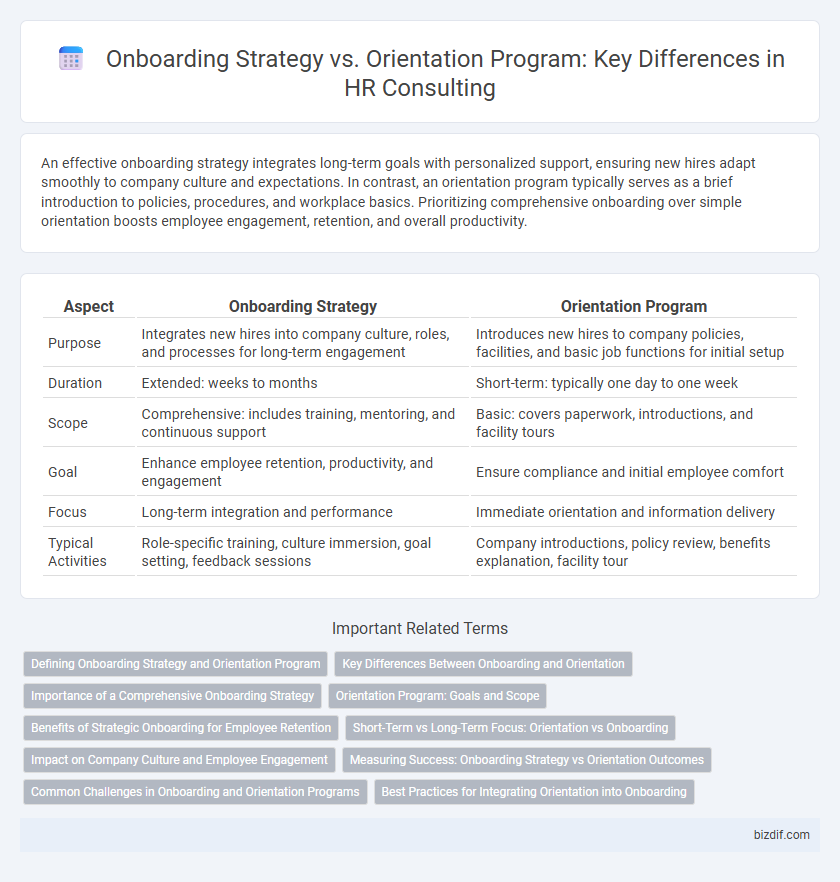An effective onboarding strategy integrates long-term goals with personalized support, ensuring new hires adapt smoothly to company culture and expectations. In contrast, an orientation program typically serves as a brief introduction to policies, procedures, and workplace basics. Prioritizing comprehensive onboarding over simple orientation boosts employee engagement, retention, and overall productivity.
Table of Comparison
| Aspect | Onboarding Strategy | Orientation Program |
|---|---|---|
| Purpose | Integrates new hires into company culture, roles, and processes for long-term engagement | Introduces new hires to company policies, facilities, and basic job functions for initial setup |
| Duration | Extended: weeks to months | Short-term: typically one day to one week |
| Scope | Comprehensive: includes training, mentoring, and continuous support | Basic: covers paperwork, introductions, and facility tours |
| Goal | Enhance employee retention, productivity, and engagement | Ensure compliance and initial employee comfort |
| Focus | Long-term integration and performance | Immediate orientation and information delivery |
| Typical Activities | Role-specific training, culture immersion, goal setting, feedback sessions | Company introductions, policy review, benefits explanation, facility tour |
Defining Onboarding Strategy and Orientation Program
Defining an onboarding strategy involves creating a comprehensive, long-term plan that integrates new hires into the company culture, aligns their roles with organizational goals, and supports continuous development. An orientation program is a tactical component of onboarding, focusing on introducing new employees to workplace policies, procedures, and team members through structured sessions. Effective onboarding strategy ensures sustained engagement, while orientation programs provide essential initial information and acclimatization.
Key Differences Between Onboarding and Orientation
Onboarding strategy encompasses a comprehensive process tailored to integrate new hires into the company culture, roles, and long-term expectations, extending beyond the initial days of employment. Orientation programs are typically shorter, focusing primarily on administrative tasks, workplace policies, and basic introductions necessary for a new employee's first day or week. Key differences include onboarding's emphasis on ongoing development and engagement versus orientation's role as a one-time informational session.
Importance of a Comprehensive Onboarding Strategy
A comprehensive onboarding strategy significantly enhances employee retention by integrating tailored training, cultural assimilation, and continuous support beyond initial orientation programs. It aligns new hires with organizational goals and values, fostering engagement and productivity from day one. Effective onboarding reduces turnover costs and accelerates time-to-competency, making it a critical component of HR consulting best practices.
Orientation Program: Goals and Scope
Orientation programs aim to accelerate new employee integration by familiarizing them with company culture, policies, and role expectations within the first days of employment. Clear objectives focus on reducing time-to-productivity, enhancing job satisfaction, and minimizing turnover rates through structured sessions and interactive activities. Scope includes compliance training, team introductions, technology setups, and performance management overviews designed to create a comprehensive foundation for long-term employee engagement.
Benefits of Strategic Onboarding for Employee Retention
Strategic onboarding significantly improves employee retention by fostering early engagement and aligning new hires with company culture and goals. Unlike traditional orientation programs that offer limited information in a single session, onboarding provides continuous support, skill development, and relationship building over several months. Companies implementing comprehensive onboarding strategies report up to 82% higher retention rates and increased productivity within the first year.
Short-Term vs Long-Term Focus: Orientation vs Onboarding
Orientation programs offer a short-term focus by providing new hires with essential information and immediate integration into company culture within the first few days. Onboarding strategies emphasize a long-term approach, fostering employee engagement, skill development, and retention over several months. Effective HR consulting advocates combining both to ensure a seamless transition and sustained productivity.
Impact on Company Culture and Employee Engagement
Onboarding strategy encompasses a comprehensive, long-term approach that integrates new hires into company culture, significantly enhancing employee engagement by fostering belonging and alignment with organizational values. Orientation programs deliver essential procedural knowledge but often lack depth in cultural immersion, limiting their impact on sustained engagement and workplace cohesion. Effective onboarding transforms new employees into active culture ambassadors, directly influencing retention rates and overall organizational performance.
Measuring Success: Onboarding Strategy vs Orientation Outcomes
Measuring success in onboarding strategy involves tracking long-term employee engagement, retention rates, and performance metrics, while orientation program outcomes typically focus on immediate knowledge acquisition and initial employee satisfaction. Effective onboarding strategies utilize data from surveys, productivity benchmarks, and turnover analysis to assess integration quality over months. In contrast, orientation evaluations often rely on feedback forms and comprehension tests administered within the first few days.
Common Challenges in Onboarding and Orientation Programs
Common challenges in onboarding and orientation programs include information overload, lack of personalization, and insufficient engagement, which can hinder new employee adjustment and productivity. Misalignment between onboarding strategy and organizational goals often results in inconsistent communication and unclear role expectations. Addressing these issues requires integrating tailored learning paths and continuous feedback mechanisms to enhance retention and job satisfaction.
Best Practices for Integrating Orientation into Onboarding
Integrating orientation programs into a comprehensive onboarding strategy enhances employee engagement and accelerates productivity. Best practices include customizing orientation content to align with company culture, providing interactive learning experiences, and extending support beyond the initial days through mentorship and feedback loops. Effective integration ensures seamless transition from new hire introduction to full role immersion, reducing turnover and fostering long-term retention.
onboarding strategy vs orientation program Infographic

 bizdif.com
bizdif.com